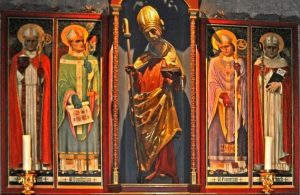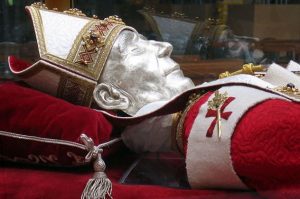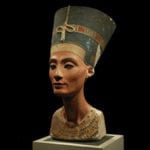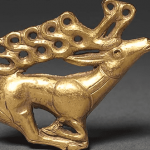 Movies and TV
Movies and TV  Movies and TV
Movies and TV  Creepy
Creepy 10 Lesser-Known Shapeshifter Legends from Around the World
 Animals
Animals 10 Amazing Animal Tales from the Ancient World
 Gaming
Gaming 10 Game Characters Everyone Hated Playing
 Books
Books 10 Famous Writers Who Were Hypocritical
 Humans
Humans 10 of the World’s Toughest Puzzles Solved in Record Time
 Mysteries
Mysteries 10 Scientific Mysteries We Don’t Fully Understand
 Weird Stuff
Weird Stuff 10 Celebrities Who Have Admitted to Alien Encounters
 Our World
Our World 10 Surprising Secrets of Notre Dame Cathedral
 Miscellaneous
Miscellaneous 10 Intriguing Origins of Popular Carnival Rides
 Movies and TV
Movies and TV 10 Actors Dragged out of Retirement for One Key Role
 Creepy
Creepy 10 Lesser-Known Shapeshifter Legends from Around the World
 Animals
Animals 10 Amazing Animal Tales from the Ancient World
Who's Behind Listverse?

Jamie Frater
Head Editor
Jamie founded Listverse due to an insatiable desire to share fascinating, obscure, and bizarre facts. He has been a guest speaker on numerous national radio and television stations and is a five time published author.
More About Us Gaming
Gaming 10 Game Characters Everyone Hated Playing
 Books
Books 10 Famous Writers Who Were Hypocritical
 Humans
Humans 10 of the World’s Toughest Puzzles Solved in Record Time
 Mysteries
Mysteries 10 Scientific Mysteries We Don’t Fully Understand
 Weird Stuff
Weird Stuff 10 Celebrities Who Have Admitted to Alien Encounters
 Our World
Our World 10 Surprising Secrets of Notre Dame Cathedral
 Miscellaneous
Miscellaneous 10 Intriguing Origins of Popular Carnival Rides
10 Times Religious Artifacts Were Stolen
Religious relics are, by their very nature, held to be sacrosanct by believers. Holy objects are venerated by a number of religions and have been for millennia. Something touched by the divine was thought to help worshippers become closer to their gods. Therefore, you might think that such objects are safe from being stolen. But religious relics have a value, and where there is a possible profit, then there will be someone willing to risk the wrath of God to steal them.
Here are ten times religious relics have been purloined throughout history.
Related: Top 10 Intriguing Cases Involving Art About Jesus
10 The Holy Foreskin
In Catholicism, holy relics were thought to offer miracles to the faithful. Something associated with a saint in life could do the trick, but even better was a part of their body. Even better than bits of saints were artifacts connected to Jesus. Unfortunately, when Jesus was taken bodily into heaven, he took most of his flesh with him. One part that was thought to still exist on Earth was the foreskin that was cut off him while he was still an infant. The Holy Prepuce, as it was known, was claimed by a number of churches in Europe.
One of the holy foreskins was held in a golden cross in Rome until the city was sacked in 1527. This is not the theft that interests us, however. From Rome, it was taken to the village of Calcata and paraded annually for believers to see.
In 1983 the parish priest made a shocking announcement to his flock—the foreskin was gone. He said that thieves had taken the relic from his home. There are some, however, who think that there may be more to this theft. By the 20th century, the Catholic church had become a bit embarrassed by people going to visit a part of Jesus’ penis. Writing or talking about the Holy Prepuce became punishable by excommunication. Was the foreskin stolen by the church itself to remove it from sight? Until it is rediscovered, the truth will likely never be known.[1]
9 Temple Menorah
If you visit Rome, you can still see the Arch of Titus, erected in the 1st century AD, to celebrate Titus’s victory over the Jewish rebels and the capture of Jerusalem by the Romans. One of the panels carved into it shows booty carried through Rome in triumph. Held aloft by the soldiers is a candelabrum with seven branches. This is the menorah which once stood in the temple of Jerusalem.
According to the Hebrew bible, it was made of solid gold and burned with consecrated olive oil throughout the night. The menorahs which had stood in the first temple were stolen by the Babylonians centuries earlier, and the one shown on the arch of Titus came from the second temple.
What happened to the menorah after its trip to Rome? According to a 2nd-century rabbi, it could still be seen in Rome at that time, but after that, it fell out of the historical record. It may have been one of the treasures the Romans displayed in their Temple of Peace. When that temple burned down, the menorah might have been destroyed, though later sources claim it was stolen again by Vandals and carried off after they took Rome.[2]
8 A Holy Bell
Visitors to Loch Shiel in Scotland could once go to an island holy to St. Finan and see a bell that might have been there for 1,000 years. Unfortunately, in 2019, it was taken by a thief and has yet to be recovered.
Security on the quiet island was not particularly effective. The bell was once attached to the altar of the ruined church by a chain that came from a lavatory. Not long before the theft, this weak chain was replaced by one hand-forged from bronze to ensure the bell could not be stolen. This did not deter the thief, however, who must have come armed with tools. Because the island is remote and uninhabited, no one knows exactly when the bell was taken.
This was not the first time the bell had been removed from the island. During the Jacobite rebellion of 1745, a British soldier had stolen the bell. When he was caught, he was soundly whipped as punishment, and the bell was returned to its home by the soldier’s officers. Locals also claim that the bell flew back to the island of its own accord after that theft. It remains to be seen if another miracle will restore the bell this time.[3]
7 Relics of St. Wolfgang

In the middle of the night on October 26, 2020, thieves broke into the Church of St. Wolfgang in Regensburg, Germany. Instead of stealing anything of more immediate value, the intruders descended on a statue of St. Wolfgang and smashed their way into the glass and steel container set into it. Within were fragments of bone and other relics of the saint, and it was these that were stolen.
St. Wolfgang had been a popular local bishop in the 10th century and was canonized soon after his death. Several miracles related to the saint sprang up in folklore. One said that he had once tricked the Devil into helping him to build a church. Whether the thieves were hoping to get a miracle from their ownership of the relics is not known.[4]
6 Dozens of Hindu Idols
The antiquities market is booming. Each year artifacts worth millions are sold at reputable auction houses and often end up in the most renowned museums that glory in their ownership of ancient objects. Often these items have impeccable provenances, which can be traced back for hundreds of years. Unfortunately, there are also dealers willing to sell objects with a vague past that appear to have emerged from thin air to unscrupulous collectors.
In 2023, the home of Shobha Durairajan in India was searched by police charged with recovering looted items. Inside the collector’s house, 55 Hindu idols were found, some dating from the 10th century, which police believe were stolen from temples. Others had been taken by the authorities from her home a year earlier.
According to Durairajan, the artifacts were purchased from Aparna Art Gallery. Unfortunately, the dealer who ran that gallery, known as Deenadayalan, has been accused of smuggling ancient objects on numerous occasions. Hopefully, these religious statues can be returned to their proper homes.[5]
5 Nepalese Gods
Sometimes even the most renowned museums can get caught up in the theft of religious items. In the early and middle of the 20th centuries, many of the great museums of the world were happy to spend their money on objects with a dubious history to help build their collections. The Metropolitan Museum in New York has had several items seized from its vast holdings by the authorities to restore them to their countries of origin.
In the 1980s, a statue of Shreedhar Vishnu that was revered in the Nepalese village of Bungmati disappeared. An empty hole was all that was left in the temple, and no one could trace the missing god. Ten years later, a statue was donated to the Metropolitan Museum and proudly displayed.
Thanks to sleuths on the internet who hunt for art looted from Nepal, the two pieces of this puzzle were put together in 2021. The museum has since removed the statue from the listings of its collection, and hopes are high that it will soon be returned to the place where it proudly stood for nearly 1,000 years.[6]
4 Buddha’s Relics
Many Buddhist societies have built Stupas, large dome-like structures that hold relics of important figures in their faith. These offer locations for meditation and other rituals to be performed, which help believers in their journey to peace. The most important relics are those belonging to the Buddha himself. When the Buddha achieved enlightenment, his followers burned his body, but teeth and bone fragments were shared out, and many places claim to have a portion of the remains.
These relics are often housed inside ornate and valuable vessels. In 2013, a golden urn which is said to contain the hair, bones, and teeth of Buddha, was stolen from a shrine in Udong, Cambodia. The theft led to public outcry, and a nationwide hunt for the holy object was launched. Early in 2014, police raided a house and found the urn. A suspect was arrested at the same time, but police are still hunting for the mastermind behind the theft. Once the robbery was detected, five of the guards at the shrine were also arrested for possible involvement.
All those arrested were found guilty of the crime and sentenced to seven years in prison. The relics were returned to their mountain shrine—and extra security was put in place.[7]
3 Pope Celestine V

Pietro Angelerio had one of the strangest careers of anyone who was ever made pope. He was an ascetic holy man of the 13th century who lived a simple life in retreat from the world. He might have died in obscurity had it not been for a particularly contested election of a new pope in 1292. When the cardinals took two years without managing to agree on who the new pope should be, Angelerio wrote them a letter saying god would be displeased with them if they delayed any longer. In frustration, one of the cardinals declared that Angelerio should be the next pope—and the rest agreed.
Angelerio is said to have refused and even tried to escape his hermitage. Eventually, he was convinced to accept and took the name Celestine V. Unfortunately, a life lived away from the power of Rome left him without the necessary skills to run the Catholic Church. After just five months, he issued a bull that declared popes could resign. Then he resigned. He tried to return to his quiet life but was dragged back into papal affairs. He died just over a year later.
Celestine also enjoyed an unconventional afterlife. His remains were placed inside a silver coffin which was stolen in 1529. A new silver coffin was made, but that was stolen in 1729. In 1988, thieves went one better and actually stole the pope himself. For two days, the remains of the pope were missing but were recovered from a graveyard hidden in a simple wooden box.
Celestine’s remains can now be seen in the city of L’Aquila, where his face is covered with a silver mask. Hopefully, no one will try to steal that, too.[8]
2 Relics of St. Foy
Relics were vital to the medieval church in Europe. Those churches that could boast ownership of important relics were guaranteed to draw huge numbers of pilgrims. With pilgrims came money that they spent and donated to your church. Competition for relics was so fierce that it even led to a whole new crime, “furta sacra”—”holy theft.”
Saint Foy was a 3rd or 4th-century Christian who is said to have been martyred for refusing to offer sacrifices to pagan gods. For her crimes, she was roasted alive and declared a saint. In the centuries following her death, the remains of her body were placed in a shrine in the town of Agen. Soon her relics were performing regular miracles, and the church in Agen grew rich.
A group of monks in the town of Conques wanted a piece of this income. They sent one of their monks to Agen to join the community there. Over ten years, he worked undercover until he was made priest there. As soon as he was able, he stole St. Foy’s relics and carried them back to Conques. They remain there today.[9]
1 Jesus’ Blood
Most relic thieves these days are less interested in them as holy objects than they are in their monetary value. Some relics are housed in gorgeously ornate and costly receptacles. When thieves broke into Fécamp Abbey in France one night in 2022, they grabbed all the glittering treasures they could lay their hands on. Probably unknown to them was that they were also stealing two vials of blood that Jesus is said to have shed at the crucifixion.
Once the thieves knew what they had taken, they seemed unsure of what to do. Many of the items taken were very distinctive and probably hard to sell anyway. They may also have become afraid of trying to sell the body of Christ.
After the theft, a Dutch art detective called Arthur Brand received a strange email claiming to be from the thieves. They offered to give him the stolen treasure and blood. Unsure whether they were genuine, he told them to leave them on his doorstep. When the doorbell rang one day, he was greeted by a box containing everything that had gone missing.[10]








